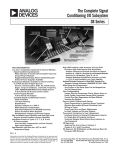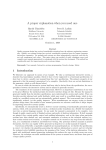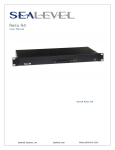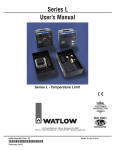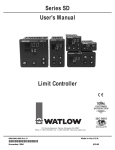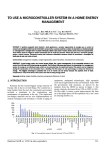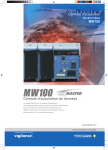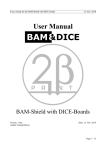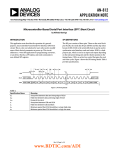Download Design Specification - Datasound Laboratories Ltd
Transcript
Design through collaboration DSL AMPIC Design Specification Product No. Document No. Issue Date Author Datasound Laboratories Limited 4 Aylesford Court, Works Road, Letchworth Garden City, Herts, SG6 1LP : : : : : 1253-000 106-062 1.1 27/11/2014 Kevin Kilford Tel: +44 (0)1462 675530 Fax: +44 (0)1462 482461 Email: [email protected] FM 38066 DSL AMPIC Design Specification Contents 1 2 3 4 5 6 Disclaimer .................................................................................................................... 4 Confidentiality .............................................................................................................. 4 Acknowledgments ........................................................................................................ 4 Record of Amendments................................................................................................ 5 Approvals ..................................................................................................................... 6 Document Organisation................................................................................................ 7 6.1 Terminology ........................................................................................................... 7 6.2 Terms, Definitions and Acronyms .......................................................................... 8 7 Problem Presentation ................................................................................................... 9 7.1 Specification .......................................................................................................... 9 7.2 Brief analysis ........................................................................................................10 8 System Environment ...................................................................................................12 8.1 TIA-232-F compatible serial networks ...................................................................12 8.2 TIA/EIA-422-B compatible serial networks ............................................................12 8.3 Ethernet LAN ........................................................................................................12 8.4 CAN Bus ...............................................................................................................12 8.5 USB device(s) and host(s) ....................................................................................12 8.6 Thermocouple.......................................................................................................13 8.7 4-20mA transmitter ...............................................................................................13 8.8 4-20mA receiver and power supply. ......................................................................13 8.9 Analog Inputs........................................................................................................13 8.10 GPIO. ................................................................................................................13 8.10.1 Isolated inputs ...............................................................................................13 8.10.2 Open Drain Outputs .......................................................................................13 8.10.3 Change-over relay outputs.............................................................................13 8.11 Temperature Sensor .........................................................................................14 8.12 microSD Card ...................................................................................................14 8.13 Application program ..........................................................................................14 8.13.1 Flash storage .................................................................................................14 8.13.2 NVRAM .........................................................................................................14 8.14 User ..................................................................................................................14 8.14.1 Momentary switch inputs ...............................................................................14 8.14.2 Character LCD...............................................................................................14 8.14.3 LEDs .............................................................................................................14 8.15 Expansion .........................................................................................................15 8.15.1 I2C Port ..........................................................................................................15 8.15.2 SPI Port .........................................................................................................15 8.15.3 TTL Serial Port ..............................................................................................15 9 Delimitation of inputs/outputs ......................................................................................16 10 Functional Specification ..............................................................................................17 10.1 Power Supply ....................................................................................................17 10.2 Microcontroller...................................................................................................18 10.2.1 SRAM ............................................................................................................18 10.2.2 Flash .............................................................................................................19 10.3 TIA-232-F compatible serial network .................................................................19 10.4 TIA-422-B/TIA-485-A compatible serial network ................................................19 10.5 TIA-422-B/TIA-485-A Interface selection ...........................................................20 10.6 microSD Card Connector ..................................................................................20 10.7 Configuration storage ........................................................................................21 10.8 NVRAM .............................................................................................................21 10.9 Thermocouple interface.....................................................................................21 Copyright © 2014 DSL Page 2 Document No. 106-062 Issue 1.1 DSL AMPIC Design Specification 10.10 4-20mA current loop driver ................................................................................21 10.10.1 Isolation .....................................................................................................22 10.11 Temperature sensor ..........................................................................................22 10.12 CAN-bus transceiver .........................................................................................22 10.13 LAN ...................................................................................................................23 10.14 USB OTG ..........................................................................................................23 10.15 USB Switching ..................................................................................................24 10.16 Analogue inputs ................................................................................................24 10.16.1 Isolation .....................................................................................................25 10.17 4-20mA current loop receiver ............................................................................25 10.17.1 Current to voltage converter .......................................................................25 10.17.2 DC-DC converter........................................................................................26 10.17.3 Isolation .....................................................................................................26 10.17.4 Analogue to Digital converter .....................................................................26 10.18 GPIO .................................................................................................................26 10.18.1 Isolated inputs ............................................................................................26 10.18.2 Open Collector Outputs ..............................................................................27 10.18.3 Change-over relay outputs .........................................................................28 10.19 LCD character display .......................................................................................28 10.20 Push buttons .....................................................................................................28 10.21 LEDs .................................................................................................................28 10.22 Expansion .........................................................................................................28 10.23 In-Circuit Debug Interface .................................................................................29 11 Technological Specifications .......................................................................................31 11.1 Geographical distribution constraints.................................................................31 11.2 Maintenance and operating safety.....................................................................31 11.2.1 Maintenance Functions..................................................................................31 11.2.2 Safety ............................................................................................................31 11.3 Electrical specifications .....................................................................................31 11.4 Miscellaneous specifications .............................................................................32 11.4.1 Product Constraints .......................................................................................32 12 Test and Certification Plan ..........................................................................................33 12.1 Prototype testing ...............................................................................................33 12.2 Production testing .............................................................................................36 12.3 Customer certification........................................................................................36 12.4 Notes ................................................................................................................36 13 Documentation ............................................................................................................37 13.1 Implementation Documentation .........................................................................37 13.2 Manufacturing Pack ..........................................................................................37 13.3 User Manual(s)..................................................................................................37 14 Additional Information .................................................................................................38 14.1 Technical Explanations .....................................................................................38 14.1.1 TIA/EIA-422-B Termination ............................................................................38 14.1.2 TIA/EIA-422-B Biasing ...................................................................................38 14.2 CAN bus Termination ........................................................................................39 14.3 Documentation sources.....................................................................................40 Copyright © 2014 DSL Page 3 Document No. 106-062 Issue 1.1 DSL AMPIC Design Specification 1 Disclaimer All information contained in this specification is believed to be accurate and reliable. However, DSL assumes no responsibility for its use. Since conditions of product use are outside our control, we make no warranties express or implied in relation thereto. We therefore cannot accept any liability in connection with any use of this information. Nothing herein is to be taken as a license to operate under or recommendation to infringe any patents. Whilst every effort has been made to ensure that this document is correct; errors can occur. If you find any errors or omissions please let us know, so that we can put them right. 2 Confidentiality The enclosed information is submitted for the purpose of describing and detailing the requirements for AMPIC. The information included in this document, in its entirety is considered both confidential and proprietary to DSL and may not be copied or disclosed to any other party without the written consent of the appropriate authority at DSL. 3 Acknowledgments Microsoft® and Windows® are registered trademarks of Microsoft Corporation in the United States and/or other countries. LINUX® is a registered trademark of Linus Torvalds. ARM® and Cortex™ are trademarks or registered trademarks of ARM Ltd or its subsidiaries. Stellaris® is a registered trademark of Texas Instruments Incorporated. Tiva™ and TivaWare™ are trademarks of Texas Instruments Incorporated The Bluetooth® word mark and logos are owned by the Bluetooth SIG, Inc. Microchip® and PIC® are registered trademarks of Microchip Technology Inc. Intel® is a registered trademark of Intel Corporation or its subsidiaries in the United States and other countries. All other products and trademarks mentioned in this document are trademarks of their respective owners. DSL has attempted to properly capitalize and punctuate trademarks, but cannot warranty that it has done so in every case. Copyright © 2014 DSL Page 4 Document No. 106-062 Issue 1.1 DSL AMPIC Design Specification 4 Record of Amendments DATE ISSUE 23-Oct-2012 27-Nov-2014 1.0 1.1 DETAILS (Include changed section numbers and implications) Initial Release Renamed to AMPIC Updated to latest document style Changed to TIVA™ Cortex®-M4 processor (7.1, 10.2, 11.2.1) 4-20mA Tx/Rx descriptions swapped (8.7, 8.8) Reduced to 4 analogue inputs (8.9, 9, 10.1.6) All SPI devices on single bus (8.15.2) Removed prototyping area (8.15.4) Added connector diagrams to represent correct orientation (10) Added prototype test plan (12.1) Updated customer approval wording (12.3) Copyright © 2014 DSL Page 5 Document No. 106-062 Issue 1.1 DSL AMPIC Design Specification 5 Approvals Commercial Approval: Derek Carpenter Managing Director DSL Engineering Approval: Keith Clutterbuck Engineering Manager DSL Client Approval1: Rory Dear Technical Sales Manager DSL 1 The client acknowledges that it is impractical to define the entire product, to manufacturing detail, within this document. In signing the approval section of this document, the client confirms that this document defines all those aspects of the design which are of significance to them. The client agrees that any unspecified items (which by implication are not of significance to them) are now the sole responsibility of DSL. The client acknowledges that “client instigated” changes to those unspecified items could have implications on previously advised timescales and/or cost. Copyright © 2014 DSL Page 6 Document No. 106-062 Issue 1.1 DSL AMPIC Design Specification 6 Document Organisation Section 7, Problem Presentation This section outlines DSL requirements for the system and a brief explanation of how it fits into their application. Section 8, System Environment This section describes the environment within which the system must operate. It describes all related entities, with their requisite data and events. The behaviour of the entities, either individually or globally, is described here. Also all entity relationships can be found in this section. Section 9, Delimitation of inputs/outputs This section shows all of the inputs and outputs for the system to be designed, the entities these go to and whether they are continuous or momentary. Section 10, Functional Specification This section describes, in detail, every function that the system must perform. This includes the precision of data and variables that each function uses, operating conditions, accuracy performances, special operating modes and predetermined methods. Section 11, Technological Specifications This section describes all constraints, such as cost, mechanical or environmental, for the system. Section 12, Test and Certification Plan This section provides a précis of the tests plan(s) to be created for the system. Also the customer certification obligations are outlined in this section. Section 13, Documentation This section outlines all required documentation, throughout the design phase. 6.1 Terminology The system described, within this document, is that which shall be designed from it. The application considered in this document shall be the closed system, having no useful relation with the outside for the problem to be solved, formed by the system to be designed and the objects related to it. The environment is all application objects, excluding the system to be designed. Objects in the environment are called entities. An object has a dynamic behaviour and has its own independence. It is necessarily a functional reality, but not necessarily physical. Copyright © 2014 DSL Page 7 Document No. 106-062 Issue 1.1 DSL AMPIC Design Specification 6.2 Terms, Definitions and Acronyms Term Definition ADC API Analogue to Digital Converter Application Programming Interface: An interface implemented by a software program to enable interaction with other software. Controller Area Network is a standard vehicular bus which allows microcontrollers and devices to communicate without a host computer. The original, yet still common, name of the serial port interface on IBM PC-compatible computers. The component side of a PCB is, conventionally, the upper side on which the components are mounted. Digital to Analogue Converter Engineering Change Request Electrically Erasable Programmable Read-Only Memory. General Purpose Input/Output. Global Positioning System is a global navigation satellite system that provides location and time information where there is an unobstructed line of sight to four or more GPS satellites. Global System for Mobile communications / General packet radio switching is a packet switching mobile data service standardised as part of the phase 2+ update to the secondgeneration GSM standard. Joint Test Action Group (JTAG) is the common name for the IEEE 1149.1 Standard Test Access Port and Boundary-Scan Architecture. It is used for testing printed circuit boards using boundary scan. Kilo Samples per second Local Area Network Medium Access Controller Megabyte Mega Samples per second Operating system See USB OTG Printed Circuit Board Pulse-width modulation Quadrature encoder interface Random Access Memory. A standard for serial binary single-ended data and control signals commonly used in computer serial ports. A point-to-point or multi-drop serial data transmission standard using balanced or differential signalling. A point-to-point or multi-drop serial data transmission standard using balanced or differential signalling. Real-Time-Clock Real-Time Operating System. Serial Peripheral Interface Bus Static Random Access Memory. The solder side of a PCB is, conventionally, the lower side where through-hole components were soldered from. Serial Wire Debug is a 2-pin low pin count and high-performance alternative to JTAG which is compatible with all ARM processors. Transistor-Transistor Logic is a class of digital circuits where both the logic gating function and the amplifying function are performed by transistors. Universal Asynchronous Receiver Transmitter Universal Serial Bus. USB On-The-Go allows a USB device to act as either a host or a peripheral, with the mode selected by the cabling utilised. CAN COM Component side DAC ECR EEPROM GPIO GPS GSM/GPRS JTAG kS/s LAN MAC MB MS/s OS OTG PCB PWM QEI RAM RS232 RS422 RS485 RTC RTOS SPI SRAM Solder side SWD TTL UART USB USB OTG Copyright © 2014 DSL Page 8 Document No. 106-062 Issue 1.1 DSL AMPIC Design Specification 7 Problem Presentation 7.1 Specification DSL are increasingly receiving requests for custom designs that require ARM® processors, or for designs that require lower performance and power consumption than x86 based processors. The low performance and consumption type of designs do not always need a full operating system, such as Microsoft® Windows®, Windows® Embedded Compact or Linux®, although they may require some real-time, deterministic, aspect. There are, currently, three families of ARM® processors: 1. Cortex™-A series are application processors which have similar multimedia capabilities and overall performance comparable to the ICOP Vortex processors or Intel® processors used in other DSL distributed products. 2. Cortex™-R series have a similar performance to the mid-range Cortex-A processors but include hardware support for real-time operating systems with features such as deterministic interrupt performance. 3. Cortex™-M series have performance equivalent to the best microcontrollers, whilst being very energy efficient. The Cortex™-M4 processors are general purpose, high performance, 32-bit, microcontroller type, processors with support for highly deterministic real-time applications. Processors based on the ARM® Cortex™-M4 core are widely available, from manufacturers including NXP, Atmel, STMicro, Texas Instruments, Toshiba and Freescale. Compilers with support for these processors are also widely available, from software houses including Keil, IAR systems, Mentor Graphics, Code Red, MikroElektronika and the processor manufacturers themselves. It is proposed to create a sensor development kit, including an ARM® Cortex™-M4 based processor with a number of inputs, outputs and user interface hardware that are predicted to be required for sensor designs. It is anticipated that clients could use this sensor development kit to fully develop and test a sensor design before requesting that DSL create a custom design for them. Development kits, manufactured by the processor manufacturers, such as Texas Instruments, all seem to be targeted toward a particular application, so have limited scope to use as a basis for another sensor type. The ‘best’ competitor development kit is manufactured by MikroElectronika. Copyright © 2014 DSL Page 9 Document No. 106-062 Issue 1.1 DSL AMPIC Design Specification This goes to the other extreme, whereby they have a baseboard with a plug in microcontroller module and plug in I/O modules. This gives total flexibility but does not necessarily make the most of the built-in capabilities of the microcontroller, as each I/O module uses a serial connection. Also this does not, necessarily, give the lowest current consumption for each function. The proposed system would provide each customer the opportunity to choose the interfaces he needs for his application, switch off the others and get as close as possible to what his own sensor design needs to be, functionally, without requiring software changes for the production version, and using the same amount power, so that they can size batteries if necessary. 7.2 Brief analysis The proposed solution will be based on a Texas Instruments TIVA™ ARM® Cortex™-M4 processor. These processors have a cost of approximately $3-$11, dependent upon the amount of included flash, RAM, peripherals and the maximum processor clock speed. Texas Instruments has a comprehensive suite of royalty free software, supporting all of the peripheral interfaces, to speed development, as well as a number of example programs that can be used as a starting point for new designs. The software, provided to drive each interface can be incorporated into your own software or is available in ROM to free storage. Texas Instruments also supply a free real-time operating system, with no run-time fees, that can be used stand-alone or with their own compiler. The Texas Instruments TIVA™ ARM® Cortex™-M4 microcontrollers are also supported by all of the major ARM® compilers. The proposed solution would include a thermocouple2 connection, an on-board temperature sensor, 4-20mA input, analogue inputs and GPIO, to provide the inputs for the sensor. The GPIO connections will be organised in such a way that some can be configured for use as a PWM output. A microSD connector will be included to provide potential data logging storage 3. System connections will be delivered using 4-20mA outputs, CAN, USB OTG and Ethernet. 2 If a Maxim MAX31855 device was used, this provides a cold-junction compensated digital temperature output via SPI bus. This part is available for K, J, N, S, T, E and R-type thermocouples, allowing us to provide a connection for the most popular type in the development kit and support all of the other types for custom designs. 3 This is not required for normal application storage. Copyright © 2014 DSL Page 10 Document No. 106-062 Issue 1.1 DSL AMPIC Design Specification One RS232 port and one RS422/RS485 port can be used as generic connections for system or sensor use. An expansion port, including I2C, SPI and a TTL serial port, with hand-shaking lines, will also be provided. Further connections, such as Bluetooth® and WiFi, can be added using AT modem modules from companies such as Multitech or U-blox on these interfaces. The GPIO ports will connect to a 2-line character LCD, momentary push buttons and LEDs to provide a simple user interface, whilst inputs will be opto-isolated and outputs will have some change-over relays and some open collector outputs. Copyright © 2014 DSL Page 11 Document No. 106-062 Issue 1.1 DSL AMPIC Design Specification 8 System Environment Analysis of the problem shows that the following entities must be considered: 8.1 TIA-232-F compatible serial networks This will network work at up to 115.2 KBaud. It will not support RTS, CTS, DCD, DTR, DSR and RI modem control lines. This is an alternate interface for connection to a host. Entity data and event definition All data and events passed both to and from the system, will meet those outlined in the TIA-232-F standard. 8.2 TIA/EIA-422-B compatible serial networks Working at up to 115.2 KBaud, this is an alternate interface for connection to a host. Entity data and event definition All data and events passed both to and from the system, will meet those outlined in the TIA/EIA-422-B and TIA-485-A standards. 8.3 Ethernet LAN This is an alternate interface for connection to a host. Entity data and event definition All data and events, passed both to and from the system, will meet the IEEE 802.3, 2000 Edition (ISO/IEC 8802-3: 2000) specification. 8.4 CAN Bus This is an alternate interface for connection to a host. Entity data and event definition The protocol for this interface will conform to the CAN protocol version 2.0 A/B and the physical layer will meet ISO 11898. 8.5 USB device(s) and host(s) This is a peripheral control interface. It may be used to connect other entities to the product or connect the product to a host. Entity data and event definition The events and data for this interface are described in the Universal Serial Bus Revision 2.0 specification. Copyright © 2014 DSL Page 12 Document No. 106-062 Issue 1.1 DSL AMPIC Design Specification 8.6 Thermocouple This allows the connection of an external, cold-junction compensated, temperature sensor. The standard build will allow the connection of a K type (Chromel-Alumel) thermocouple, whilst build options will allow the use of other thermocouple types. Entity data and event definition The data will in 14-bit digital format4, with a resolution of 0.25°C. This will register temperatures from -270°C to 1375°C, with a K-Type thermocouple5. This will not generate an event or interrupt and will need to be polled. 8.7 4-20mA transmitter This is an analogue current loop device, which controls the loop current to represent a single parameter. The application program will be responsible for the appropriate scaling. 8.8 4-20mA receiver and power supply. This is an analogue current loop device which can interpret a single parameter transmitted from the system as a current correlated to the parameter. This can be used to connect external sensors. The input will be converted to an analogue voltage, which can be read by the application program. The application program will be responsible for any scaling necessary to convert this to the original sensor’s units. 8.9 Analog Inputs Four analog inputs will be provided for application use. The application program will be responsible for interpreting and scaling. 8.10 GPIO. 8.10.1 Isolated inputs Eight isolated inputs will be provided for application use. 8.10.2 Open Drain Outputs Six open drain outputs will be provided for application use. 8.10.3 Change-over relay outputs Two change-over relays, with 240VAC switching capability, will be provided for application use. 4 12-bit unit and two bits for the fraction The temperature returned will be calculated using a linear relationship between the thermocouple voltage and temperature. This will require software correction to allow for any non-linearity in the thermocouple. 5 Copyright © 2014 DSL Page 13 Document No. 106-062 Issue 1.1 DSL AMPIC Design Specification 8.11 Temperature Sensor The system will include a temperature sensor to read the approximate ambient temperature around the system. Entity data and event definition This will read temperatures of, at least, -40°C to 85°C. This will have a resolution of 9 bits and an accuracy of ±2°C. This will not generate an event or interrupt and will need to be polled. 8.12 microSD Card This will provide optional local, flash based, storage to allow the application to perform any data logging function necessary. Entity data and event definition All data and events passed both to and from the system, will meet those outlined in the SD Specifications Version 3.01 SPI Mode. 8.13 Application program This is the customer’s software. It provides a unique service to the user making the system part of a larger whole. 8.13.1 Flash storage In addition to the program storage, will be provided to store any relevant configuration parameters 8.13.2 NVRAM NVRAM will be provided to allow the application program to record any run-time parameters that are required to be retained during power down situations. This will operate faster than the flash but will not be as fast as the normal program SRAM. 8.14 User User interaction will be provided by the application program and can include the use of the following interface functions: 8.14.1 Momentary switch inputs Four momentary switches will be provided for application use. 8.14.2 Character LCD A two line character LCD, with a common 8-bit parallel interface, will be provided for application use. 8.14.3 LEDs Two LEDs will be provided for application use. Copyright © 2014 DSL Page 14 Document No. 106-062 Issue 1.1 DSL AMPIC Design Specification 8.15 Expansion Expansion of the system for additional application requirements will be met with the following ports: 8.15.1 I2C Port This is a serial port which has a common connection to the on-board temperature sensor. Entity data and event definition All data and events passed both to and from the system, will meet those outlined in the I2C-Bus specification. 8.15.2 SPI Port This is a serial port which has a common connection to the thermocouple, the 420mA input and the on-board storage devices. 8.15.3 TTL Serial Port This is a UART serial port, with modem control lines and TTL signal levels. This will network work at up to 115.2 KBaud. It will support RTS, CTS, DCD, DTR, DSR and RI modem control lines, where possible, to permit the use of AT modem modules, where required. Copyright © 2014 DSL Page 15 Document No. 106-062 Issue 1.1 DSL AMPIC Design Specification 9 Delimitation of inputs/outputs Thermocouple RS232 Serial Port RS232 Temperature Sensor RS422/485 Serial Port RS422/485 4-20mA current loop Ethernet LAN Ethernet 4-20mA current loop Serial Data CAN Bus Serial Data 8 Digital Inputs Serial Data USB OTG Serial Data System to specify 6 Digital Outputs Serial Data I2C Port Serial Data Change-over Relay Outputs 2 Serial Data SPI Port Serial Data 4 Analog Inputs Serial Data Flash Serial Data microSD Card Serial Data NVRAM Serial Data Serial Data TTL Serial Port Serial Data Copyright © 2014 DSL Page 16 Document No. 106-062 Issue 1.1 DSL AMPIC Design Specification 10 Functional Specification 10.1 Power Supply This function will accept a regulated 5V DC input and generate any additional supplies necessary for the application. This will allow a customer to power the development board, using either a laboratory power supply or an ICOP desktop power supply. This may not reflect the power supply requirements of the end application. Any additional power supply regulation, protection or battery switching and charging circuits will need to be prototyped separately and incorporated into a product designed from the sensor development kit. Methods This device will be provided with a, vertically mounted, 2-way screw terminal and a Kycon KPJX-3S connector in parallel. The pin-out of the terminal connector will be as follows: 1 5V IN 2 0V IN The pin-out of the Kycon connector will be as follows: 1 5V IN 2 0V IN 3 N/C Copyright © 2014 DSL Page 17 Document No. 106-062 Issue 1.1 DSL AMPIC Design Specification 10.2 Microcontroller This function will provide the storage for the OS and application code and execute both. This will require connections to the following interfaces: 3 off asynchronous serial ports for communications with: o TIA-232-F compatible peripheral devices o TIA-422-B or TIA-485-A compatible peripheral devices o Expansion devices, with handshaking lines SPI port for communication with: o microSD Card o Flash, for application configuration storage o NVRAM, for non-volatile application variable storage o Thermocouple o 4-20mA outputs o Expansion devices I2C-Bus for communication with: o Temperature sensor o Expansion devices Can-Bus interface Ethernet LAN controller USB OTG controller for communication with USB hosts and devices Analogue to digital converters6 for 4-20mA input(s) and general application use General purpose input/output7 (GPIO) for: o LCD character display o Push button inputs o LED outputs o General application use JTAG interface (for debug support and application programming) Use of specific components This should use a Texas Instruments TIVA™ ARM® Cortex™-M4 Microcontroller. 10.2.1 SRAM This function will provide temporary data storage for the application program, running on the Microcontroller. Methods The Texas Instruments TIVA™ ARM® Cortex™-M4 Microcontroller family include devices with between 12KB and 256KB of SRAM. 6 7 Support for analogue comparators should be provided where possible Support for QEI and PWM should be provided where possible Copyright © 2014 DSL Page 18 Document No. 106-062 Issue 1.1 DSL AMPIC Design Specification 10.2.2 Flash This function will provide program storage for the application. Methods The Texas Instruments TIVA™ ARM® Cortex™-M4 Microcontroller family include devices with between 32KB and 1024KB of flash. These devices can also include TIVAware™ software in ROM, which provides royalty-free functions for controlling the microprocessor’s peripherals, reducing the application flash requirements. 10.3 TIA-232-F compatible serial network This function will provide the TIA-232-F compatible transceiver. No handshaking lines will be implemented. Methods This device will be provided with a, vertically mounted, 3-way screw terminal. The pin-out of this connector will be as follows: 1 RxD 2 GND 3 TxD Electrical interface specifications The TIA-232-F pins must include ±15kV (Human body model) ESD protection. The electrical characteristics for the TIA-232-F send/receive function must meet the TIA-232-F standard. Temporal Specifications (Timing constraints) The data packets for the TIA-232-F send/receive function must meet the TIA-232-F standard. 10.4 TIA-422-B/TIA-485-A compatible serial network This function will provide the transceivers for a 4-wire TIA-422-B compatible network or a 2-wire TIA-485-A compatible network. The network type will be selectable. See 10.5 below. No handshaking lines will be implemented. Copyright © 2014 DSL Page 19 Document No. 106-062 Issue 1.1 DSL AMPIC Design Specification Methods This device will be provided with a, vertically mounted, 6-way screw terminal. The pin-out of this connector will be as follows: Mode 422 485 1 TXTX-/RX2 TX+ TX+/RX+ 3 GND GND 4 RX- N/C 5 RX+ N/C 6 GND GND Electrical interface specifications The electrical characteristics for the TIA-422-B send/receive function must meet the TIA/EIA-422-B standard. The electrical characteristics for the TIA-485-A send/receive function must meet the TIA-485-A standard. Temporal Specifications (Timing constraints) The data packets for the TIA-422-B send/receive function must meet the TIA/EIA422-B standard. The data packets for the TIA-485-A send/receive function must meet the TIA-485-A standard. Provision will be made, in the design, for both a termination resistor and bias resistors to be fitted, but these will not be fitted as standard. 10.5 TIA-422-B/TIA-485-A Interface selection This function will enable the selection of the interface type, between RS485, 2-wire, half duplex and RS422, 4-wire, full duplex modes. Methods This port will be switchable between 2-wire and 4-wire modes, via an on-board jumper. 10.6 microSD Card Connector This function will provide the capability of connecting a microSD card to the microcontroller. Electrical interface specifications The connection should conform to the SD Specifications Version 3.01 SPI Mode Copyright © 2014 DSL Page 20 Document No. 106-062 Issue 1.1 DSL AMPIC Design Specification 10.7 Configuration storage This function will provide additional, EEPROM based, storage, for application use. This could be used to store configuration parameters. Methods This function should use an SPI device connected in a de-facto industry standard 8pin package. 10.8 NVRAM This function will provide non-volatile storage, for application use. This could be used to store run-time variables that need to be retained despite power failures, such as a tachometer total value. Methods This function should use an SPI device connected in a de-facto industry standard 8pin package for flash and EEPROMs. 10.9 Thermocouple interface This function will provide the connection for an external thermocouple, cold-junction compensation, for the thermocouple, and translation from the thermocouple voltage into a temperature value8. Methods This device will be provided with a, vertically mounted, 2-way screw terminal. Use of specific components If a Maxim MAX31855 device was used, this provides a cold-junction compensated digital temperature output via SPI bus. This part is available for K, J, N, S, T, E and R-type thermocouples, allowing provision for the most popular K-type in the development kit and support for all of the other types for custom designs. 10.10 4-20mA current loop driver This function will provide a 4-20mA current loop transmitter, with the current output to be controlled by the application. This function will also provide the means necessary to connect the current loop power supply to the loop, if required by the end user. 8 The voltage to temperature conversion may use a linear equation and therefore any non-linearity, of the thermocouple used, may need software compensation to be applied. Copyright © 2014 DSL Page 21 Document No. 106-062 Issue 1.1 DSL AMPIC Design Specification Methods This device will be provided with a, vertically mounted, 4-way screw terminal. The pin-out of this connector will be as follows: 1 2 3 4 10.10.1 EXITATION VOLTAGE + EXITATION VOLTAGE 4-20mA + 4-20mA - Isolation This will provide isolation for the current loop and power supply to the rest of the circuit. 10.11 Temperature sensor This provides the ability to detect the current ambient temperature. Use of specific components This will use an LM75 compatible device with the I2C bus directly connected to the microcontroller. 10.12 CAN-bus transceiver This function will provide the physical and transfer layers of a CAN-bus transceiver, meeting the ISO 11898 standard. Methods This device will be provided with a, vertically mounted, 4-way screw terminal. The pin-out of this connector will be as follows: 1 2 3 4 CAN V+ (5V) CAN H CAN L GND Electrical interface specifications The electrical specification for this interface shall meet the ISO 11898 standard. Temporal Specifications (Timing constraints) All temporal specifications will meet the CAN protocol version 2.0 A/B. Copyright © 2014 DSL Page 22 Document No. 106-062 Issue 1.1 DSL AMPIC Design Specification 10.13 LAN This function will provide the termination for the Ethernet controller, including the Ethernet 1:1 transformer and connector. Methods This device will be provided with a, horizontally mounted, 8-way RJ45 (Modular) connector. The pin-out of this connector will be as follows: 1 TX+ 2 3 RX+ 4 5 N/C 6 7 N/C 8 1 TXN/C RXN/C 8 To Maximise the EMI performance the unused (N/C) conductors will be terminated with 75Ω and 1.5nF to the RJ45 shield. Electrical interface specifications The interface should conform to the IEEE 802.3, 2000 Edition specifications. Temporal Specifications (Timing constraints) The interface should conform to the IEEE 802.3, 2000 Edition specifications. 10.14 USB OTG This function will provide a connection to either a USB device or to a USB Host. Methods This port will be provided with a USB microAB socket. The pin-out of this connector will be as follows: 1 VBUS 2 D3 D+ 4 ID 5 GND Copyright © 2014 DSL Page 23 Document No. 106-062 Issue 1.1 DSL AMPIC Design Specification To enable the connection of a USB device a USB microA plug to USB A socket adapter will be provided. To enable the system to be connected to a host a USB microB to USB A plug will be provided. Electrical interface specifications The interface used should meet the Universal Serial Bus Revision 2.0 specification. Temporal Specifications (Timing constraints) The interface used should meet the Universal Serial Bus Revision 2.0 specification. 10.15 USB Switching As power is drawn through the USB interface when connected to a USB device, both the product and external peripherals will be protected from excess current draw either damaging devices or crashing the system. This function should also provide the facility for the power to be turned off by the microcontroller when a USB host is plugged in. Electrical interface specifications A maximum of 500mA can be drawn from the USB port. If a device draws in excess of 500mA the USB power will be removed and a signal will be provided to the microcontroller. 10.16 Analogue inputs This function will provide 4 Analogue 0-3V inputs, for application use. Any signal conditioning and signal attenuation required for the final application needs to happen externally. Variable/Data precision These inputs need to have, a minimum, of 10 bit resolution. Copyright © 2014 DSL Page 24 Document No. 106-062 Issue 1.1 DSL AMPIC Design Specification Methods This device will be provided with a, vertically mounted, 8-way screw terminal. The pin-out of this connector will be as follows: 1 2 3 4 5 6 7 8 AI1 AI_GND AI2 AI_GND AI3 AI_GND AI4 AI_GND Use of specific components These can be implemented using the microcontroller 10-bit ADC inputs9. Temporal Specifications (Timing constraints) These inputs need to be capable of a throughput of, at least, 100kS/s. 10.16.1 Isolation This will provide isolation for the analogue inputs to the rest of the circuit. 10.17 4-20mA current loop receiver This function will provide a 4-20mA current loop receiver. This function will also provide the means necessary to connect the current loop power supply to the loop, if required by the end user. Methods This device will be provided with a, vertically mounted, 4-way screw terminal. The pin-out of this connector will be as follows: 1 2 3 4 10.17.1 EXITATION VOLTAGE + EXITATION VOLTAGE 4-20mA + 4-20mA - Current to voltage converter This converts the current to a voltage. 9 Support for analogue comparators should be provided where possible Copyright © 2014 DSL Page 25 Document No. 106-062 Issue 1.1 DSL AMPIC Design Specification 10.17.2 DC-DC converter This takes power from the current loop to power any isolated circuitry on the loop side of the isolation. 10.17.3 Isolation This will provide isolation for the current loop and power supply to the rest of the circuit. 10.17.4 Analogue to Digital converter This will create a digital representation of the current in the loop. Variable/Data precision These inputs need to have, a minimum, of 10 bit resolution. Use of specific components This can utilise one of the microcontroller 10-bit ADC inputs. Temporal Specifications (Timing constraints) This needs to be capable of a throughput of, at least, 100kS/s. 10.18 GPIO This function provides I/O functionality to be driven by the application. 10.18.1 Isolated inputs This provides eight opto-isolated inputs, for application use. Methods This device will be provided with a, vertically mounted, 16-way screw terminal. Copyright © 2014 DSL Page 26 Document No. 106-062 Issue 1.1 DSL AMPIC Design Specification The pin-out of this connector will be as follows: 1 2 3 4 5 6 7 8 9 10 11 12 13 14 15 16 10.18.2 DI1 DI_GND DI2 DI_GND DI3 DI_GND DI4 DI_GND DI5 DI_GND DI6 DI_GND DI7 DI_GND DI8 DI_GND Open Collector Outputs This provides six open drain outputs, for application use. Methods This device will be provided with a, vertically mounted, 12-way screw terminal. The pin-out of this connector will be as follows: 1 2 3 4 5 6 7 8 9 10 11 12 DO1 DO_VCC DO2 DO_VCC DO3 DO_VCC DO4 DO_VCC DO5 DO_VCC DO6 DO_VCC Any inductive load transient suppression necessary will be included within the design, rather than requiring external components. Copyright © 2014 DSL Page 27 Document No. 106-062 Issue 1.1 DSL AMPIC Design Specification 10.18.3 Change-over relay outputs This provides two change-over relays, with 240VAC 5A switching capability, for application use. Methods This device will be provided with a, vertically mounted, 6-way screw terminal. The pin-out of this connector will be as follows: 1 2 3 4 5 6 R1 NO R1 COM R1 NC R2 NO R2 COM R2 NC 10.19 LCD character display This will provide a 16x2 cost-effective alphanumeric LCD module, to be used under application control, as part of a human machine interface where necessary. 10.20 Push buttons This will provide four momentary push buttons, to be used under application control, as part of a human machine interface where necessary. E.g. MENU, UP, DOWN and SELECT. These will correctly recognise separate button presses but are not required to recognise any concurrent presses. Concurrent presses can be ignored or recognised as one of the buttons pressed. 10.21 LEDs This will provide two LED outputs, to be used under application control, as part of a human machine interface where necessary. E.g. HEATING ENABLED and HOT WATER ENABLED. 10.22 Expansion This function will provide an expansion interface. A second connector will provide a TTL level UART with the full complement of handshaking lines to allow the connection of AT modems. Methods This will use a 10-way 0.1” shrouded header in a UEXT configuration. Copyright © 2014 DSL Page 28 Document No. 106-062 Issue 1.1 DSL AMPIC Design Specification The pin-out of this connector will be as follows: 1 3 5 7 9 3.3V TTL UART TXD I2C SCL SPI MISO SPI SCK 2 4 6 8 10 GND TTL UART RXD I2C SDA SPI MOSI SPI CSn This UART will use a 10-way 0.1” shrouded header. The pin-out of this connector will be as follows: 1 3 5 7 9 DCD# RXD TXD DTR# GND 2 4 6 8 10 DSR# RTS# CTS# RI# GND 10.23 In-Circuit Debug Interface The microcontroller flash can be programmed via the JTAG/SWD port, on the device. This can also be used, with a number of the development tools, to provide software debugging support. This will also provide 1 USB to UART interface that can be used with the Texas Instruments® TIVA™ boot loader or serial flash loader code to program the microcontroller flash. Methods The JTAG connection will be made using a 10-way 0.05” pitch shrouded header10. The pin-out of this connector will be as follows: 1 3 5 7 9 10 3.3V GND GND Key GNDDetect 2 4 6 8 10 TMS/SWDIO TCK/SWCLK TDO/SWO TDI RESETn ® Whilst this is a lesser recognised connector for ARM JTAG/SWD, it will take much less board space than a 20-way 0.1” shrouded header. Copyright © 2014 DSL Page 29 Document No. 106-062 Issue 1.1 DSL AMPIC Design Specification The UART connection will be made using a 10-way 2mm pitch pin header. The pin-out of this connector will be as follows: 1 N/C 2 RxD 3 TxD 4 N/C 5 GND 6 N/C 7 N/C 8 N/C 9 N/C 10 +5V The programming hardware consists of a USB to JTAG adapter using an FTDI FT2232 USB debug controller. Reference designs for these are available from TI and FTDI. Whilst this functionality will be integrated into the board design, the PCB should be laid out in such as fashion that this can be removed from the finished board and used to debug a finished product designed from the development kit. This will draw no power from the board in normal use, allowing the power requirement for a design to be ascertained. Copyright © 2014 DSL Page 30 Document No. 106-062 Issue 1.1 DSL AMPIC Design Specification 11 Technological Specifications 11.1 Geographical distribution constraints The Ethernet network allows for a maximum of 100m between devices. The TIA485-A network allows for a maximum network length of 1200m. 11.2 Maintenance and operating safety 11.2.1 Maintenance Functions The JTAG/SWD interface, in combination with the ICDI, can be used to both program the microcontroller flash and to debug any application, where supported by the development software. The Texas Instruments® TIVA™ boot loader code, loaded into ROM on selected TIVA™ microcontrollers, also provides flash loading via serial connections. This provides flash loading over UART, SSI, I2C, SSI, Ethernet, CAN and USB. The microcontroller fitted to the development kit will include ROM. TIVA™ microcontrollers without ROM have a one-time-use serial flash loader loaded into flash. This provides flash loading over UART or SSI. Microcontrollers without ROM may be used in designs created from the development kit. 11.2.2 Safety The system does not include any high voltage, or high current, interfaces. This system is not intended for medical or military use. As such there are no requirements for fault tolerance. The system should meet Council Directive 73/23/EEC, the Low Voltage Directive. All due diligence will be applied during design to ensure that the system does not compromise the user’s safety. 11.3 Electrical specifications The system should be powered by a 5V regulated supply11. No current consumption limit has been specified, although this should be kept to a minimum and any potentially unused interfaces, in end user applications, should have the facility to be turned off. This will facilitate the design of battery powered end-user applications. 11 The external power supply MUST be monotonic at power-up. Careful consideration of the current capacity of the external power supply and the entire loading it will experience at power-on, due to inrush currents, should be assessed to ensure that this will be the case. Copyright © 2014 DSL Page 31 Document No. 106-062 Issue 1.1 DSL AMPIC Design Specification 11.4 Miscellaneous specifications 11.4.1 Product Constraints The system operating conditions will meet the following: o Operating Temperature -40ºC to +85ºC All parts, selected by DSL, will either be lead free or have a lead free alternative, such that the product may meet the requirements of the Restriction of Hazardous Substances directive (RoHS). The system design must be made in consideration for European electromagnetic compatibility (EMC) laws. This includes; protecting all interfaces, where they leave the system, from vulnerabilities to electrostatic discharge (ESD); and protecting the system from electromagnetic interference (EMI). Copyright © 2014 DSL Page 32 Document No. 106-062 Issue 1.1 DSL AMPIC Design Specification 12 Test and Certification Plan 12.1 Prototype testing All printed circuit boards (PCBs) for prototype units will be bare board tested. All prototype units will be visually inspected prior to testing. Inspection will determine if components are correctly fitted, solder joints are of sufficient quality and the units meet the required overall quality, including cleanliness et cetera. Static handling requirements will be adhered to throughout all stages. All power supplies will be tested to determine that they supply the correct voltage, they regulate over the required input range and that they provide an acceptable ripple voltage level. All functions of the system will be functionally tested and all aspects tested to the specifications outlined in this document, where viable. All prototype boards will be serial numbered and individual record sheets of the following tests will be kept for each unit. Function Power Supply How to test The 3.3V rail will be checked, using an oscilloscope for the correct output and ripple voltages. In-Circuit Debug The system will be programmed, using the ICD, with the Interface demonstration firmware: This provides a simple menu to exercise the outputs and display the inputs and major system parameters. LCD character The LCD is used by the demonstration firmware. display Different menu items will drive each character on the LCD, such that its correct operation can be confirmed. Push buttons All four push buttons will be used to navigate the menu during the tests. LEDs The LEDs will alternately flash, at 1Hz, when the demonstration firmware is operational. TIA-232-F This port will echo all received characters. compatible serial An external system will be connected, with the port configured for network 9600 baud and 8-N-1 operation, and the received characters will be compared to the sent to ensure that these match. TIA-422-B/TIAThis port will echo all received characters. 485-A compatible An external system will be connected using a USB to RS485 serial network adapter configured for 4-wire, full duplex, operation, with the port configured for 9600 baud and 8-N-1 operation, and the received characters will be compared to the sent to ensure that these match. TIA-422-B/TIAThe AMPIC will be reconfigured for 2-wire RS485 operation. 485-A Interface The USB to RS485 adapter will be reconfigured for 2-wire, half selection duplex operation and set to enable its drivers only when transmitting. The port will then be rechecked to ensure that all echoed characters match those previously sent. microSD Card The microSD Card will store a log file of changes to the digital Result Copyright © 2014 DSL Page 33 Document No. 106-062 Issue 1.1 DSL AMPIC Design Specification Connector Configuration storage NVRAM Thermocouple interface 4-20mA current loop driver Temperature sensor CAN-bus transceiver LAN USB Analogue inputs 4-20mA current loop receiver Isolated inputs Open Collector Outputs Change-over relay outputs outputs, Relays and 4-20mA driver, driven from the menu. For instance ‘Digital Output 1 set to high’. After making some of these changes the micro SD card will be removed from the AMPIC system and the log file verified. The EEPROM will be used to store the data to display when booting. As this is written when not found in the EEPROM the value to write will be changed in the firmware whilst ensuring that the sign on text does not change. The currently set values for the Digital Outputs, Relays and 420mA drivers will be stored in NVRAM when changed. The values will then be verified following a power cycle. A K-Type thermocouple will be connected and the reading, shown in the menu, compared to the reading from a digital thermometer with a K-Type thermocouple. The current loop driver will be set in steps of 1mA, from 4mA to 20mA, and the output verified, within 1%, using a, UKAS Calibrated, Volt/mA Loop Calibrator. The reading of the LM75 temperature sensor will be verified using a digital thermometer, with K-Type thermocouple attached to the top of the part. An external CAN Bus node will send a request, using a base frame format with an 11-bit identifier, to 0x101. The AMPIC will reply with the string ‘-AMPIC!-’ The LAN port will be verified by connecting to a 100 speed Ethernet network with DHCP server. Correct communication will be verified by ensuring that an IP address has been leased to the AMPIC via the menu. The USB port will be verified, in host mode, by connecting a USB keyboard and using this to drive the menu. Right Arrow or ENTER keys = SELECT. Left Arrow = MENU. Up Arrow = Up. Down Arrow = Down. Each analogue input will be independently driven using a 1.5V and adjustable voltage divider. The menu reading, for each, will be verified using a digital multimeter. The 4-20mA receiver will be driven using a, UKAS Calibrated, mA Loop Calibrator in steps of 1mA, from 4mA to 20mA, and the value verified within 1% using the menu. The digital inputs will be controlled using external switches and the current state verified using the menu. The digital outputs will be independently controlled, using the menu, and their state verified using external LEDs. The relays will be energised using the menu and the state measured using a multi-meter. Copyright © 2014 DSL Page 34 Document No. 106-062 Issue 1.1 DSL AMPIC Design Specification Copyright © 2014 DSL Page 35 Document No. 106-062 Issue 1.1 DSL AMPIC Design Specification 12.2 Production testing All printed circuit boards (PCBs) for production units will be bare board tested. All production units will be visually inspected prior to testing. Inspection will determine if components are correctly fitted, solder joints are of sufficient quality and the units meet the required overall quality, including cleanliness et cetera. No components will be reused on production units. Static handling requirements will be adhered to throughout all production stages. All production units will be fully functionally tested prior to shipment. 12.3 Customer certification The customer will be required to verify acceptance that the following elements of the design comply with the requirements of this document: Electronic Design Mechanical Design PCB Layout Firmware Software The approval tests can occur at the customer’s premises or, following prior application, may occur at DSL’s premises with one of DSL’s engineers present. 12.4 Notes DSL will use best practice, throughout the design, to ensure that the electromagnetic effects, emitted by and affecting the product, are limited. As type approval tests may often be applied to prototype units the following statements should be noted: Prototype units may be delivered a number of track cuts and wire modifications applied. These will be considered acceptable providing that the reliability and functionality of the system is not impaired. Initial production units will not have any wire modifications applied. Due to component lead times prototypes may use parts which do not comply with the requirements of this document. These deviations must be agreed with the customer. Copyright © 2014 DSL Page 36 Document No. 106-062 Issue 1.1 DSL AMPIC Design Specification 13 Documentation 13.1 Implementation Documentation All design steps will be documented. Thus any technological or implementation specifications will be formally documented. All documents and calculations used to develop a solution will be included. The design will be verified at all stages and documents used for verification and validation will be signed and retained. 13.2 Manufacturing Pack The following documents will be supplied for manufacturing the product: Full parts list. Artwork in the form of extended Gerber Files in RS274X format. List of programmed parts with object file(s), source file(s) and documentation of the programming hardware and software necessary. PCB and programmed parts labelling instructions. Any additional documentation required to manufacture and assemble electronic circuits, such as cleaning requirements. Assembly drawings Cable drawings Test procedure including software required to test. Following initial manufacture any modifications or changes made to affect functionality, reliability or manufacturability will be documented using an engineering change note or additional work instruction. 13.3 User Manual(s) A User Manual will be supplied for this system. It will fully describe the completed system, in all its iterations, and describe all interfaces and their connection. An installation manual will be supplied. Copyright © 2014 DSL Page 37 Document No. 106-062 Issue 1.1 DSL AMPIC Design Specification 14 Additional Information 14.1 Technical Explanations 14.1.1 TIA/EIA-422-B Termination Termination is used to match the impedance of a transmitting or receiving node to the impedance of the transmission line used. If the impedances are mismatched the transmitted signal cannot be fully absorbed by the load and some portion of the signal will be reflected back onto the transmission line. This reflected signal will travel up and down the cable reducing in amplitude over time. The disadvantages of terminating are: Driver loads are increased. Biasing requirements are changed. Whether termination is required, on a network, should be based upon the total cable length and the data rate employed. If all signal reflections will be damped out prior to the centre of a data bit, at which point the receiver will be sampling, termination will not be required. For example the propagation delay of any cable can be calculated from its length and propagation velocity (typically 66-75% of the speed of light (c)). If a cable of 100m has a round trip of 200m and a propagation velocity of 66% of c, one round trip is completed in approximately 1μs. Assuming that the reflections are completely damped after 5 round trips, the signal will stabilise after 5μs. At 9600 baud each bit is 104μs wide. As the signal is stable well before the centre of the bit termination should not be required. At 115.2k baud each bit is 8.7μs wide. As the signal is not stable before the centre of the bit termination will be required. Termination resistors should only be placed at the extreme ends of a network, and no more than two termination resistors should be used per network. The above calculation shows that, we should be able to have a network length of about 160m before termination is needed at 115.2k baud. To allow use of this product in many different networks termination will not be included, although provision will be added should termination be necessary in the future. 14.1.2 TIA/EIA-422-B Biasing When a TIA/EIA-422-B or TIA-485-A network is idle all nodes are set to receive data and therefore all drivers are tri-stated. Without anything driving the network the state of the line is unknown. If the voltage at the receiver inputs is less than ±200mV the receiver output logic level will show that of the last bit received. Copyright © 2014 DSL Page 38 Document No. 106-062 Issue 1.1 DSL AMPIC Design Specification In order to maintain the correct idle state bias resistors can be added to the transmission lines. A pull-up resistor, typically to +5V, is added to RX+ and a pulldown, to ground, is added to RX-. The bias resistor values are determined by the network load, including terminations if fitted: When termination resistors are fitted the loading effect of these is greater than the nodes, which have a typical load of 12kΩ per node. This means that the bias resistor values are approximately 685Ω regardless of the number of nodes. When termination is not fitted the bias resistors can vary from 122kΩ for two nodes to 4.5kΩ for 32 nodes. Bias resistors can be added at any point on the network or can be split among multiple nodes. The parallel combination of all bias resistors on a network should be equal to or less than the biasing requirements. To allow use of this product in many different networks bias resistors will not be included, although provision will be added should bias resistors be necessary in the future. 14.2 CAN bus Termination ISO 11898-2 describes the electrical implementation formed from a multi-dropped single-ended balanced line configuration with resistor termination at each end of the bus. In this configuration a dominant state is asserted by one or more transmitters switching the CAN- to supply 0V and (simultaneously) switching CAN+ to the +5V bus voltage thereby forming a current path through the resistors that terminate the bus. As such the terminating resistors form an essential component of the signalling system and are included not just to limit wave reflection at high frequency. During a recessive state the signal lines and resistor(s) remain in a high impedances state with respect to both rails. Voltages on both CAN+ and CAN- tend (weakly) towards ½ rail voltage. During a dominant state the signal lines and resistor(s) move to a low impedance state with respect to the rails so that current flows through the resistor. CAN+ voltage tends to +5V and CAN- tends to 0V. A recessive state is only present on the bus when none of the transmitters on the bus is asserting a dominant state. Irrespective of signal state the signals lines are always in low impedance state with respect to one another by virtue of the terminating resistors at the end of the bus. As the system could be placed at any point within a CAN-Bus network, and the resistor terminations must be placed at either end, the system will not include any termination resistors; however provision will be made to fit them if necessary. Copyright © 2014 DSL Page 39 Document No. 106-062 Issue 1.1 DSL AMPIC Design Specification 14.3 Documentation sources IEEE 802.3, 2000 Edition (ISO/IEC 8802-3: 2000) is available from the Institute of Electrical and Electronics Engineers, Inc. More information can be found on the website http://www.ieee.org. EIA-232 standard is produced by the Electronic Industries Alliance. More information and links to suppliers of these documents can be found on the Electronic Industries Alliance website, http://www.eia.org. ANSI/TIA-232-F-1997 standard is produced by the Telecommunications Industry Association. More information and links to suppliers of these documents can be found on the Telecommunications Industry Association website, http://www.tiaonline.org. ANSI/TIA/EIA-485-A-98 standard is produced by the Telecommunications Industry Association. More information and links to suppliers of these documents can be found on the Telecommunications Industry Association website, http://www.tiaonline.org. ANSI/TIA-422-B-1994 standard is produced by the Telecommunications Industry Association. More information and links to suppliers of these documents can be found on the Telecommunications Industry Association website, http://www.tiaonline.org. Universal Serial Bus Revision 2.0 specification is available from the USB Implementers Forum, Inc. website: http://www.usb.org. CAN Specification Version 2.0 is available from Robert Bosch GmbH. More information can be found on the website http://www.semiconductors.bosch.de ISO 11898 is produced by ISO – International Organization for Standardization. More information can be found on the website http://www.iso.org SD Specifications Version 3.01 is available from the SD Association website http://www.sdcard.org. 2 The I C-Bus Specifications are available from NXP Semiconductors. More information can be found on the website http://www.nxp.com IEEE 1149.1 Standard Test Access Port and Boundary-Scan Architecture, commonly known as JTAG is available from the Institute of Electrical and Electronics Engineers, Inc. More information can be found on the website http://www.ieee.org. DIRECTIVE 2002/95/EC OF THE EUROPEAN PARLIAMENT AND OF THE COUNCIL of 27 January 2003 on the restriction of the use of certain hazardous substances in electrical and electronic equipment, covering the regulations referred to as RoHS is available from the European Union website http://europa.eu. Council Directive 89/336/EEC, the Electromagnetic Compatibility Directive, and its amending directives are available from the European Union website http://europa.eu. Council Directive 73/23/EEC, the Low Voltage Directive, and its amending directives are available from the European Union website http://europa.eu. The Electromagnetic Compatibility (Amendment) Regulations 1994 and its amending regulations are available from Her Majesty’s Stationary Office website http://www.hmso.gov.uk. DIRECTIVE 2002/95/EC OF THE EUROPEAN PARLIAMENT AND OF THE COUNCIL of 27 January 2003 on the restriction of the use of certain hazardous substances in electrical and electronic equipment, covering the regulations referred to as RoHS is available from the European Union website http://europa.eu. Copyright © 2014 DSL Page 40 Document No. 106-062 Issue 1.1









































